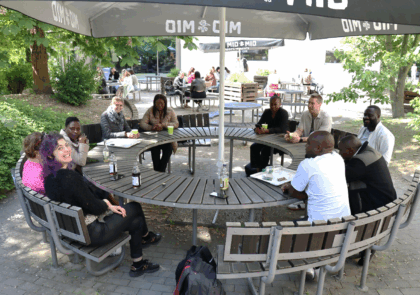
Commonly agreed and standardized terminology is essential to enable better understanding and communication between stakeholders in BIM-based construction projects. This article presents the most common BIM terms according to different sets of standards, esteemed organizations and Finnish national guidelines.
Authors: Lumiere Mwila, Jarno Rautiainen & Timo Lehtoviita
In 2020, “BIM Integration in Higher and Continuing Education,” BIM-ICE was initiated at LAB University of Applied Sciences. The 2,5-year project is co-funded by the European Union and aims to improve productivity and quality within the construction industry by developing BIM (Building Information Modelling) education in the sector. Important goal is also to enhance the availability of a skilled and professional workforce. Many topics, important to BIM use, were studied during the project. One such topic was a study on the most common BIM terminologies.
Common BIM terminology report overview
The most common BIM terminologies were reviewed by analyzing and comparing guidelines and standards. As a result, the body of knowledge related to BIM terms was synthesized, and implications for practice were suggested. (Mwila et al. 2022) The ISO 19650, International standards are taking over Building Information Modeling, and most countries, including Finland, seek to implement operational models from these standards into their national BIM guidelines. Finnish Common BIM requirements (COBIM) guidance were used to study and gather common BIM terminology and some terms were presented in the RASTI project report. RASTI was a project that presented the roadmap for digitalization in the construction sector in Finland.
Key terms of BIM
Key terms of BIM were chosen from the collected common BIM terminology. Key terms are listed in table 1 and explained in next chapters.
Building information modeling is mainly used in the AEC (Architectural, Engineering, and construction) industry, and it is a method, a process of creating and controlling the lifecycle of construction projects. On the other hand, Building Information Model is the product itself, one of the results of the process. In addition to the two aforementioned meanings, the acronym BIM sometimes refers to Building Information Management, in other words, the management and exchange of information.
Construction projects require multiple designers to collaborate on files in various formats and exchange information rapidly and accurately, this is when the interoperability of BIM is put to test, and this is where openBIM and vendor-neutral data formats such as IFC (Industry Foundation Classes) step in. An OpenBIM is the use of software, processes, and standards for facilitating information exchange, whereas an IFC is a format that can be used to exchange information between two or more BIM software programs that use IFC without loss of data. BIM projects are mainly related to graphical data and performance issues. Models are composed of BIM objects such as walls, slabs, columns, and building accessories. BIM object is a combination of geometry object and product information. BIM objects can be checked by using Clash checking, which identifies the method used to detect whether two building parts interfere with one another.
Any construction project based on building information modeling principles needs in the beginning of an BIM Execution Plan (BEP). BIM utilization and information delivery during the project needs project information model (PIM). Then BIM is also expanding from design and construction into the operational phase with the utilization of Asset Information Model (AIM), which is the single source of all information related to the management of a structure. Information is managed in common data environment (CDE) solution and workflow should be used for managing and disseminating each information container during asset management and project delivery.
Building information model enables modeling in 3D, 4D, 5D even to 7D. A 3D model is probably the most known form of BIM, which represents the 3-dimensional axis (x,y,z) of a structure, followed by the BIM 4D, which introduces scheduling information to the model as the fourth dimension, and BIM 5D, which focuses on including the cost information in a model. As-Built BIM is a model that has been updated with location information from as-built measurements and the correct product information.
Digital twins (DT) could be used to visualize models virtually to reflect a physical object. The core terms for BIM are presented in the table 1.
| Terms | Description | Sources |
| Building Information Model (BIM) | Shared digital representation of physical and functional characteristics of any built object, including buildings, bridges, roads, process plant | (ISO/TS 12911 2012) |
| Building Information Modelling (BIM) | Use of a shared digital representation of a built asset to facilitate design, construction, and operation processes to form a reliable basis for decisions | (SFS-EN ISO 19650-1 2019) |
| Building Information Management BIM(M) | Sometimes building Information Management but as BIM(M) Building Information and Management. | (PAS 1192-2 2013) |
| Asset Information Model(AIM) | Information model relating to the operational phase | (SFS-EN ISO 19650-1 2019) |
| As-Built BIM | The as-built BIM is a model that has been updated to include the changes made in construction and commissioning. The as-built BIMs are updated in repair construction projects or periodically. | (COBIM Part 3 2012) |
| OpenBIM | Extends the benefits of BIM (Building Information Modeling) by improving the accessibility, usability, management, and sustainability of digital data in the built asset industry. At its core, openBIM is a collaborative process that is vendor neutral. OpenBIM processes can be defined as sharable project information that supports seamless collaboration for all project participants. OpenBIM facilitates interoperability to benefit projects and assets throughout their lifecycle. | (BuildingSMART 2022) |
| Industry Foundation Classes(IFC) | Industry Foundation Classes is a standard used in the construction sector (EN ISO 16739) for transmitting object-based building or infrastructure information from one computer system to another. | (RASTI 2019) |
| BIM Objects | BIM objects, the components that make up a BIM model, are intelligent, have geometry, and store data. If any element is changed, BIM software updates the model to reflect that change. This allows the model to remain consistent and coordinated throughout the entire process so that structural engineers, architects, MEP engineers, designers, project managers, and contractors can work in a more collaborative environment. | (McPartland 2017) |
| Clash checking | A ‘clash’ is the result of two elements in your design taking up the same space. In Building Information Modeling (BIM), clash detection is the technique of identifying if, where, or how two parts of the building (e.g., plumbing, walls, etc.) interfere with one another. | (Spatial Corp 2021) |
| BIM Execution Plan (BEP) | Plan prepared by the suppliers to explain how the information modelling aspects of a project will be carried out | (SFS-EN ISO 19650-2 2019) |
| BIM 4D | 4D BIM adds scheduling information to model construction sequences. Adding a dimension of time allows the project team to better visualize how the construction will be sequenced. From a contractor’s point of view, this is vital. 4D BIM was a huge step forward for the industry when first made possible through the use of new modelling tools – it demonstrated collaboration between the design and construction team through coordination and sharing of 3D models. | (NBS 2021) |
| BIM 5D | 5D BIM is generally considered to be adding cost information to a model. If discussing 5D BIM, it is advised to clearly set out these specific requirements. | (NBS 2021) |
| Information | Reinterpretable representation of data in a formalized manner suitable for communication, interpretationor processing | (SFS-EN ISO 19650-1 2019) |
| Information container | Named persistent set of information retrievable from within a file, system, or application storage hierarchy | (SFS-EN ISO 19650-1 2019) |
| Information model | Set of structured and unstructured information containers | (SFS-EN ISO 19650-1 2019) |
| Project information model (PIM) | The PIM supports the delivery of the project and contributes to the AIM to support asset management activities. The PIM should also be stored to provide a long-term archive of the project and for auditing purposes. For example, the PIM can contain details of project geometry, location of equipment, performance requirements during project design, method of construction, scheduling, costing, and details of installed systems, components, and equipment, including maintenance requirements, during project construction. | (SFS-EN ISO 19650-1 2019) |
| Common Data Environment (CDE) | Agreed source of information for any given project or asset , for collecting, managing and disseminating each information container through a managed process. | (SFS-EN ISO 19650-1 2019) |
| Digital Twin (DT) | A digital twin (DT) – also referred to as digital shadow, digital replica, or digital mirror – is a digital representation of a physical asset. Linked to each other, the physical and digital twins regularly exchange data throughout the PBOD lifecycle and use phase. Technology like AI, machine learning, sensors, and IoT allows for dynamic data gathering and right-time data exchange to take place | (buildingSMART International 2020) |
Table 1. Key terms of BIM
Why do we need term definitions of BIM terminology?
Defining and understanding terms of BIM is the first step to understanding the idea and possibilities of BIM. Without clear terms it is also very difficult to learn BIM workflow. Understanding key terms of BIM are also important to clients, officials, and end users, not only civil engineering professionals. During the collection work it became clear that the use of many terms is still not the same in different countries even they are defined in international standards. In some cases, there were even variability between description in standards.
Commonly agreed, shared terminology is a requirement to enable better information flow be-tween tasks and to further develop the construction sector (RASTI 2019, 9). In Finland, standardized BIM terminology could be created simultaneously with the integration of ISO 19650 standards into Finnish BIM guidelines. The terminology could support the update of the current BIM guidance, the Common BIM Requirements 2012 publication series. It should follow the international standards that have been adopted as European Standards, and extract terms that do not exist on an international scale from the current national guidelines for terminology. The terminology should always be updated after revisions of the standards because replacing the old standards may change some of the terms.
In the future, the terminology glossaries also need a graph or a concept map presentation for how different BIM concepts are related to each other within the framework of information content and processes of the built environment.
References
buildingSMART International. 2020. The buildingSMART Digital Twins Working Group (DTWG). Cited 30 Nov 2022. Available at https://www.buildingsmart.org/digital-twins/
BuildingSMART. 2022. What is openBIM. BuildingSmart international. Cited 28 Nov 2022. Available at https://www.buildingsmart.org/about/openbim/openbim-definition/
COBIM Part 3. 2012. Common BIM Requirements part 3: Architectural design. buildingSMART Finland. Cited 25 Nov 2022. Available at https://drive.buildingsmart.fi/s/mfrRxKoZYCXiK4X
ISO/TS 12911. 2012. Framework for building information modelling (BIM) guidance. International Organization for Standardization. Cited 25 Nov 2022. Available at https://www.iso.org/standard/52155.html
Mwila, L., Rautiainen, J. & Lehtoviita, T. 2022. Common BIM terminology. LAB University of Applied sciences. BIM-ICE project open MOOC platform. Available at https://mooc.lab.fi/course/search.php?areaids=core_course-course&q=bim-ice
McPartland, N. R. 2017. What are BIM objects? National Building specification. Cited 25 Nov 2022. Available at https://www.thenbs.com/knowledge/what-are-bim-objects
NBS. 2021. BIM dimensions – 3D, 4D, 5D, 6D BIM explained. National Building Specification. Cited 25 Nov 2022. Available at https://www.thenbs.com/knowledge/bim-dimensions-3d-4d-5d-6d-bim-explained
PAS 1192-2. 2013. Specification for information management for the capital/delivery phase of construction projects using building information modelling. British Standards Institution. Cited 25 Nov 2022. Available at https://knowledge.bsigroup.com/products/specification-for-information-management-for-the-capital-delivery-phase-of-construction-projects-using-building-information-modelling/standard
RASTI. 2019. RASTI report – Standardization of information management in the built environment. Assessment of the present situation and a proposal for measures. Version 1.0. Cited 22 Nov 2022. Available at https://rastiprojekti.com/uutiset/rasti-report-released/
SFS-EN ISO 19650-1. 2019. Organization and digitization of information about buildings and civil engineering works, including building information modelling (BIM). Information management using building information modelling. Part 1. Finnish Standards Association. Cited 22 Nov 2022. Available at https://online-sfs-fi.ezproxy.saimia.fi/fi/index/tuotteet/SFS/CENISO/ID2/1/733407.html.stx
SFS-EN ISO 19650-2. 2019. Organization and digitization of information about buildings and civil engineering works, including building information modelling (BIM). Information management using building information modelling. Part 2: Delivery phase of the assets. Cited 22 Nov 2022. Available at https://online-sfs-fi.ezproxy.saimia.fi/fi/index/tuotteet/SFS/CENISO/ID2/1/733428.html.stx
Spatial Corp. 2021. What is Clash Detection. Cited 25 Nov 2022. Available at https://www.spatial.com/resources/glossary/what-is-clash-detection
Authors
Lumiere Mwila worked as a project assistant at LAB University of Applied Sciences, in BIM-ICE-project.
Jarno Rautiainen works as an RDI-specialist at LAB University of Applied Sciences in BIM and civil engineering projects as well as occasionally in short educator roles in BIM centric courses.
Timo Lehtoviita works as a senior lecturer at LAB University of Applied Sciences and as a BIM expert in projects such as BIM-ICE.
Illustration: https://pxhere.com/en/photo/1363202 (CC0)
Published 10.1.2023
Reference to this article
Mwila, L., Rautiainen, J. & Lehtoviita, T. 2023. Common BIM terminology and key terms of BIM. LAB Pro. Cited and date of citation. Available at https://www.labopen.fi/lab-pro/common-bim-terminology-and-key-terms-of-bim/






